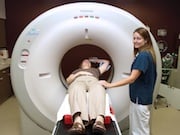
A large bore CT scanner helps the Cancer Care Center at Great River Medical Center easily accommodate obese patients or those who require special positioning.
Obesity has been a growing healthcare concern in the United States for a number of years and it only seems to be getting worse. The Centers for Disease Control and Prevention (CDC) estimates that one-third of U.S. adults are obese and notes there is not one state in the union that has met the nation’s “Healthy People 2010” goal of lowering obesity prevalence to 15 percent. While in 2000, no state had a prevalence of 30 percent or more, in 2010, there were 12, up from nine in 2009.[1]
America’s growing girth is a challenge for radiation technologists tasked with positioning patients in imaging systems designed for smaller-sized individuals. Systems manufacturers have worked to develop units to accommodate larger patients, creating couchtops that hold more weight and overcoming technological obstacles to make bores wider and still obtain a high-quality image, both in computed tomography (CT) and magnetic resonance (MR) units. As more systems gain U.S. Food and Drug Administration (FDA)clearance and enter the market, the results are better patient care and fewer headaches for imaging pros.
Large Bore CT Improves Cancer Care
The Cancer Care Center at Great River Medical Center in West Burlington, Iowa, offers comprehensive medical and surgical services on an inpatient and outpatient basis. It oftentimes was finding it difficult to do optimal CT scans required for treatment planning for its many large patients.
“Iowa has its share of generously proportioned patients, and it was always a challenge to be able to get the larger folks on the table and stable, because of the weight limits,” said William McGinnis, M.D., clinical associate professor of radiation oncology, University of Iowa Roy and Lucille Carver School of Medicine and medical director at Great River. “With our old scanner, it also was hard to get them into the small bore and into treatment position. With some of the positioning equipment we have, like our inclined breast boards, it was very difficult. Either we couldn’t do it at all or we had to modify their position.”
About two years ago, Great River purchased a Toshiba Aquilion large bore CT system and it no longer has to make such modifications.
“It also allows us to do a better job on areas that are not centered in the field of view,” McGinnis said. “For example, we just had two patients with cancer that had spread into their elbow areas. It is very difficult to get the elbow away from the body to do the scanning. But we can do it now.
“It also has made it much better for our breast cancer patients to have the wide bore machine – we can get their arms out at a better angle. We can scan them easily now,” he added.
The wide bore scanner also helps the cancer center do better treatment planning, McGinnis said. “In some of the very large patients, the FOV of the old scanner wasn’t sufficient to get all their tissue in there. Before, you would have to extrapolate normal soft tissue. With the new scanner, we don’t have to do that any more.”
Having more room to maneuver also means more comfort and less clautrophobia for the patient, McGinnis noted. “Many patients come in and notice the wide opening and feel more relaxed,” he said.
Less Claustrophobic MRIs
Early MRI machines with their very small bores were difficult for many patients, especially those suffering from claustrophobia. But to increase the bore size was a technological challenge for manufacturers, because it was difficult to obtain higher field strength in a large bore to get a high-quality image. However, a few vendors accomplished that feat, and there now are some units with a 70 cm bore.
“In comparison to a 60 cm system, it makes a world of difference,” said Robert B Smith, RT, B.S. (R) (MR) (CT), who is MRI supervisor at the Imaging Center of Saint Barnabas Ambulatory Care Center in Livingston, N.J. The facility has four MRI systems, including its newest addition, an Ingenia 1.5T wide bore from Philips Healthcare.
“It has helped us facilitate serving a wide spectrum of patients,” Smith said. “It is designed for obese patients, and it has been a great help, especially with claustrophobics.
“We see a lot of sports-related injuries. Large-size patients in general fit into this machine much more easily,” he added. “We can use it in its full capability. And if patients are claustrophobic, we can use this, too.”
Although one of the other MRI units at Saint Barnabas is a high-field open bore, Smith said they are able to get higher field strengths with the wide bore unit. The system was installed shortly after Thanksgiving last year and has been running pretty much nonstop since then, he added. “We do everything on it — breast MR, body, pelvis, spines,” he said. “It is high-field and can accommodate the large patients. We are pleased with it.”
Smith said that initially, he was a little hesitant about how it would work. “But I’ll tell you about our first patient done in the Ingenia 1.5. He was 570 pounds. He laid down on the table and went right in. I was sold after that point.”
References:
1 www.cdc.gov/obesity/data/adult.html


 December 15, 2025
December 15, 2025 









